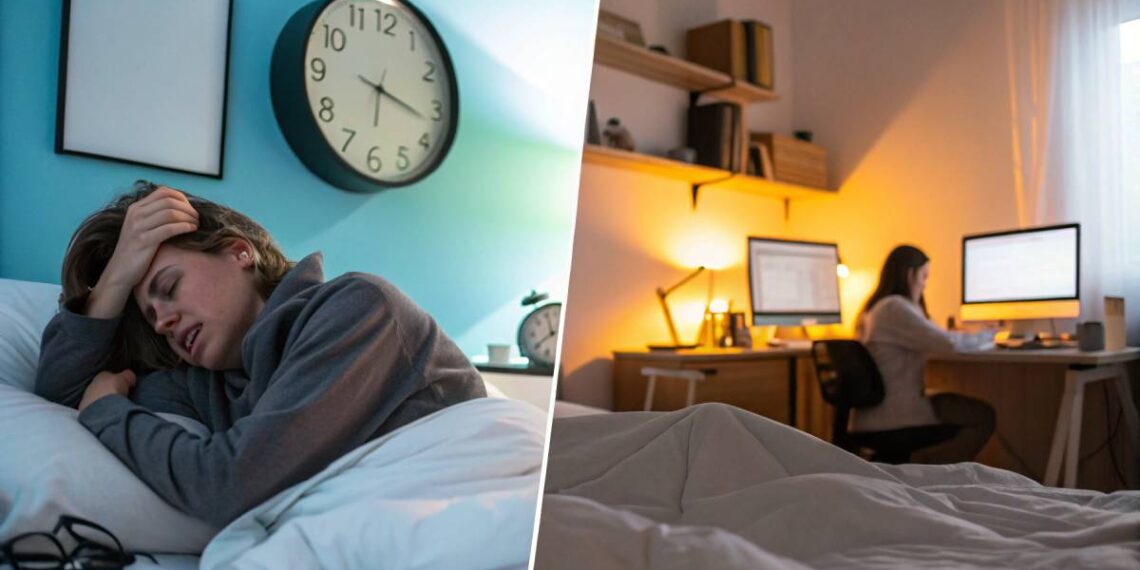Struggling with sleep? You’re not alone. In our fast-paced world, quality sleep has become the ultimate luxury that millions chase nightly. The difference between restless nights and blissful slumber often lies in simple yet powerful strategies that align with your body’s natural rhythms. Discover how transforming your bedroom environment, managing stress, and establishing consistent routines can revolutionize your sleep quality and awaken a more energized, focused, and healthier version of yourself—starting tonight.
Key Takeaways
- Consistent sleep schedules regulate your body’s internal clock, improving both sleep quality and daytime energy
- Creating an optimal sleep environment (60-67°F, dark, and quiet) significantly enhances sleep quality
- Managing stress through physical activity, mindfulness, and relaxation techniques helps quiet the mind before bedtime
- Diet and exercise timing play crucial roles in sleep quality—avoid caffeine after lunch and exercise at least 3 hours before bedtime
- Reducing screen time before bed helps maintain natural melatonin production and promotes faster sleep onset
- Different groups (shift workers, parents, students) require tailored sleep strategies to address their unique challenges
- Professional help should be sought for persistent sleep disorders like insomnia, sleep apnea, and restless legs syndrome
Sleep Improvement Strategies for a Restful Night
Getting a good night’s sleep is a game-changer for feeling your best. Let’s chat about why great sleep matters and what might mess it up.
Importance of Quality Sleep
Catchin’ those Z’s is crucial for keeping you at the top of your game. It’s tied to how well your brain works, your mood, and even your health. Skipping quality sleep can leave you feeling foggy, cranky, and can mess with your long-term health.
“Sleep is the golden chain that ties health and our bodies together.” – Thomas Dekker
When you sleep well, your body thanks you with:
- Sharper thinking: You’ll notice your brain’s on point—better focus, more ideas, all that good stuff.
- Happier vibes: Mood swings, see ya later! Stress? Who’s she?
- Stronger body: Keep those germs at bay and your heart happy.
Want to know more about how sleep changes everything in life? Check out our article on ways to boost your sleep game.
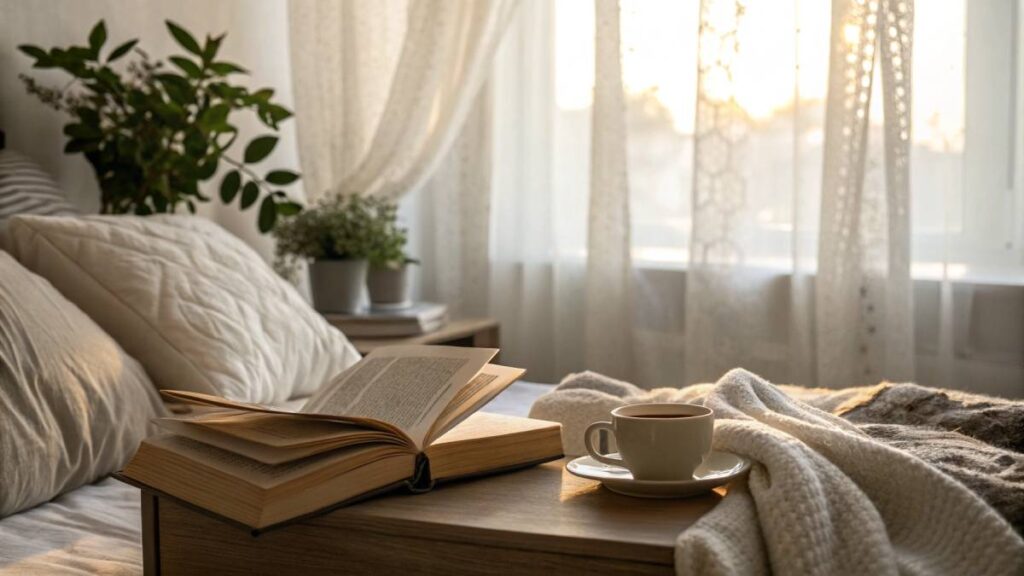
Factors Affecting Sleep
Plenty of things can turn sleep into a struggle. Knowing what these are can help you catch them Z’s in peace.
| Factor | Sleep Effect |
|---|---|
| Stress and Anxiety | Tossing and turning all night? Yep, that’s stress for ya. |
| Diet | Heavy late-night munchies and that afternoon coffee make sleep hard. |
| Physical Activity | Exercise is great, just don’t pump iron right before bed. |
| Exposure to Light | That screen glow at night? A real sleep-killer. |
| Room Vibes | If your room’s too noisy, too bright, or has the wrong temp, you’re not sleeping well. |
| Sleep Schedule | Random bedtimes drive your body clock bonkers. |
Peep our better sleep tips for easy hacks to sidestep these and catch better sleep.
By appreciating why sleep’s a big deal and knowing what to look out for, you can fine-tune your habits for a better snooze. Be it through natural sleep boosters or tweaking your bedtime behavior, tiny tweaks can make a world of difference. For more personalized sleep advice, dive into our expert sleep hacks.
Establishing a Sleep Routine
Getting into a groove for a good night’s sleep isn’t just some fancy luxury—it’s absolutely doable and can work wonders in upping the snooze quality. You know how your body kind of gets used to things when you do them at the same time every day? Well, that’s what a sleep routine does! Here’s how you can rock this sleep game with a steady bedtime and an ultra-chill sleep zone.
“Your future depends on your dreams, so go to sleep.” – Jim Henson
Consistent Bedtime
Think of a consistent bedtime like clockwork, but cozier. Hitting the sack and getting up at the same time every day—even when it’s tempting to binge movies all weekend—keeps your internal clock working smoothly, helping you conk out and wake up feeling bright-eyed and bushy-tailed.
| Day | Bedtime | Wake-Up Time |
|---|---|---|
| Monday | 10:00 PM | 6:00 AM |
| Tuesday | 10:00 PM | 6:00 AM |
| Wednesday | 10:00 PM | 6:00 AM |
| Thursday | 10:00 PM | 6:00 AM |
| Friday | 10:00 PM | 6:00 AM |
| Saturday | 10:00 PM | 6:00 AM |
| Sunday | 10:00 PM | 6:00 AM |
Nailing a regular bedtime isn’t just about the clock; it’s about winding down right. Chill with a book, soak in a nice bath or try some deep breaths to slow things down. Want more hacks for a steady sleep routine? Our sleep hygiene tips article spills the tea.

Creating a Relaxing Sleep Environment
Your bedroom should feel like a zen cave that screams “nap time.” Cozy, cool, and dark are your best friends here.
- Comfort Matters: Dig into the delight of a bed that’s made for dreaming. Soft pillows and a mattress that feels just right can make all the difference. Toss on some comfy cotton or linen sheets too!
- Chill Factor: Turn the temp down to a comfy cool between 60-67°F (16-19°C). Think of your bedroom as an igloo of slumber.
- Lighting Mood: Less light, more dreams. Ditch the bright lights and consider blackout curtains or a sleep mask for that pitch-dark vibe.
To set the sleepy mood, try spritzing the air with some lavender magic or plugging in a white noise machine to hush those pesky distractions. More on crafting your dream-worthy bedroom over at our sleep optimization tips.
Start weaving these habits into your life, and you’ll be on your way to sleep bliss that’ll have you waking up refreshed and chipper. If you’re on the hunt for more go-to sleep tricks, our guides on proven sleep improvement techniques and effective sleep improvement strategies are just a click away.
Managing Stress and Anxiety
Stress and worry can really mess with your snooze. Being keyed up or anxious might block the door to dreamland. Tackling these feelings can chill nighttime chaos for anyone chasing better sleep advice.
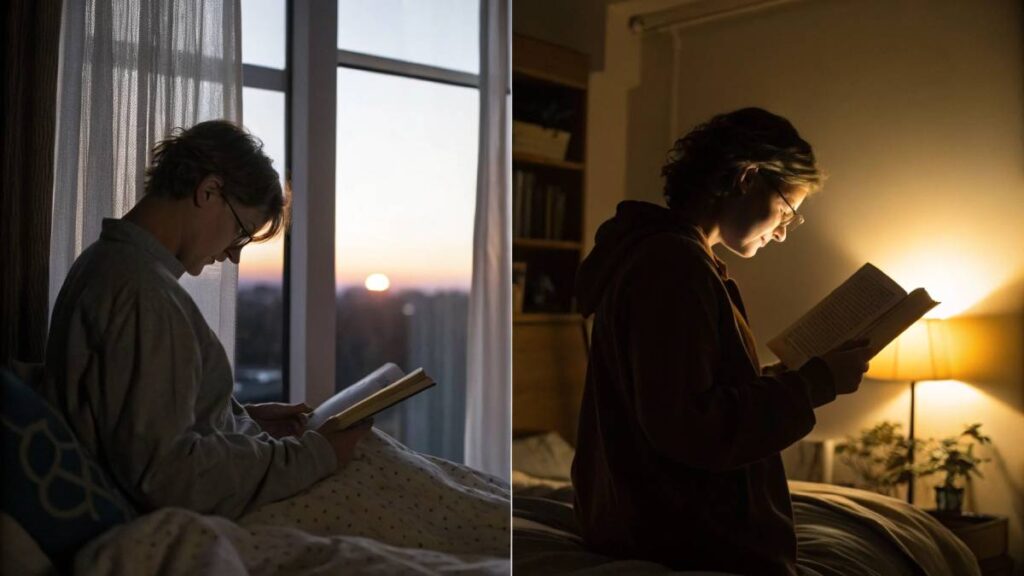
Ways to Chill Out
Lowering stress levels can really dial up the snooze game. You don’t have to reinvent the wheel—just a few tried-and-true approaches might help you stress less:
- Move Your Body: Break a sweat; you’ll find that big stress ball in your chest shrinks down.
- Breathe it Out: Inhale, exhale, repeat. Simple deep breaths can press pause on all that noise in your head.
- Get it Together: Plan ahead; making a list helps keep that overwhelmed vibe at bay.
- Play Time: Dive into a hobby; it’s like a mini-vacation from your daily grind.
| Thing to Do | How Much it Helps (1-10) |
|---|---|
| Move Your Body | 9 |
| Breathe it Out | 8 |
| Get it Together | 7 |
| Play Time | 8 |
If you want more tricks on tweaking your sleep, throw some of these moves into your day.
Getting Your Zen On
Mindfulness and meditation can mellow out anxiety and get you sleeping like a baby. Staying in the here-and-now can take the buzz out of bedtime thinking.
Why Chill and Meditate?:
- Quiet Your Brain: It stops those nagging thoughts that keep you up.
- Zen Vibes: Throws you into relax mode, which is the on-ramp to Sleep Town.
- Dreamland Quality: Leads to sleep that truly recharges your batteries.
| Zen Technique | Chill Factor (1-10) |
|---|---|
| Guided Meditation | 9 |
| Mindful Breathing | 8 |
| Body Scan | 7 |
Adding these into your routine could score you more z’s. Check our article about natural sleep boosters for more info.
Understanding and rolling with these methods can knock stress and anxiety out of your sleep space, letting you flip to dreamland with ease. For more ways to sleep better, dig into our detailed guides.
Healthy Sleep Habits
Getting a good night’s sleep is easier when you adopt some healthy habits. Let’s dive into how moving your body and eating right can help you catch those Zs.
Regular Exercise
Exercising during the day can work wonders for your slumber. It helps your body clock tick right and gets you snoozing faster once you hit the sheets. Aim for at least 150 minutes of moderate to intense sweat sessions each week—your bed’ll thank you.
| Exercise Type | Frequency | Duration |
|---|---|---|
| Aerobic (e.g., walking, cycling) | 3-5 days/week | 30-45 mins/session |
| Strength Training | 2-3 days/week | 20-30 mins/session |
Check out these sleep tips to avoid breaking a sweat too close to bedtime—it might keep you wide-eyed longer than you’d like.
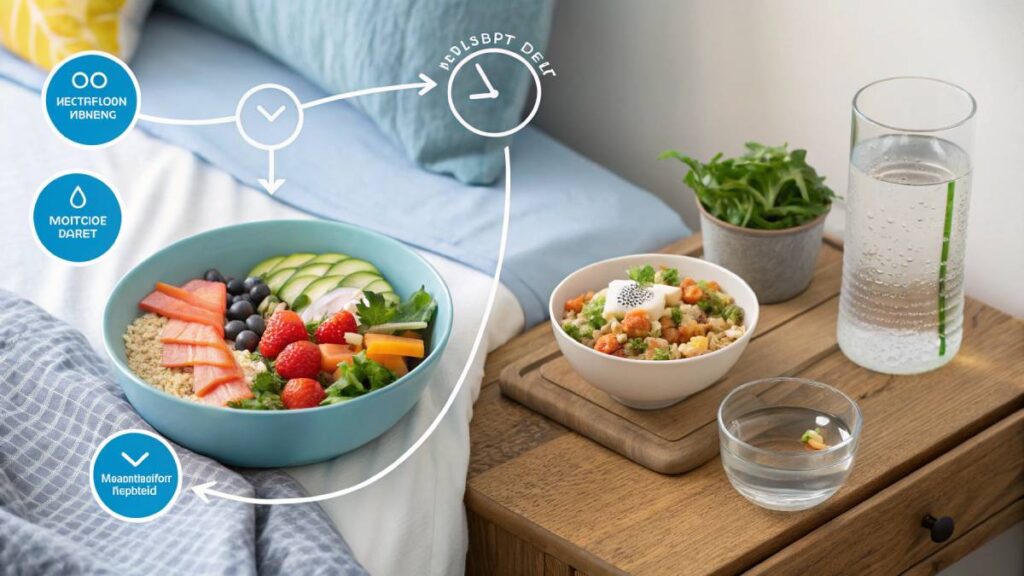
Balanced Diet and Hydration
Eating balanced meals and staying hydrated gives your sleep routine a boost. Munch on a mix of foods packed with the good stuff your body needs. Steer clear of big meals, caffeine, and booze before bed—they’re infamous for wrecking quality sleep.
| Nutrient | Foods | Benefits for Sleep |
|---|---|---|
| Magnesium | Spinach, almonds, avocado | Helps you chill out |
| Tryptophan | Turkey, eggs, nuts | Gets that sleepy-time serotonin and melatonin flowing |
| Calcium | Dairy products, leafy greens | Team player in melatonin production |
| Hydration | Water, herbal teas | Keeps dehydration at bay |
Head over to this guide to stick with meal times and sip fluids wisely throughout the day for restful nights. Just don’t overdo it on the water in the PM to dodge those late-night wake-up calls.
Adopting these sleep-friendly habits is a smart move for better rest. We’ve got more science-backed sleep tips and natural sleep hacks—dive into our stash for a snug night’s sleep.
Optimizing Your Bedroom
Let’s talk turkey—creating the ultimate sleep zone means transforming your bedroom from a mere place to crash into your personal dream retreat. You’d be shocked at how the right setup can turn your nights from meh to marvellous. Buckle up for some real talk on snuggly bedding and getting your bedroom’s vibe (temperature and lighting) just right for a glorious night’s rest.
Comfortable Bedding
Bedding is the MVP when it comes to snooze land. Pick the right mattress and pillows to cradle your body like a baby wrapped in a hug—bye-bye, discomfort and restless nights.
Elements of Comfortable Bedding
- Mattress: Get yourself a spine-loving mattress—one that’s not as hard as your ex’s heart but firm enough to support the natural curve of your back.
- Pillows: Whether you’re a side-sleeper, back-sleeper, or somewhere in between, find pillows that keep your head and neck chillaxing in a comfy, neutral spot.
- Sheets: Go for sheets breathing life into your sleep. Natural fibers like cotton or linen are the cat’s pajamas for keeping you cool and cozy.
- Blankets: Don’t play Goldilocks—pick blankets that won’t turn you into a popsicle or a melted mess, depending on the season.
Want the lowdown on how to bedding-up your sleep game? Dive into our sleep optimization tips.
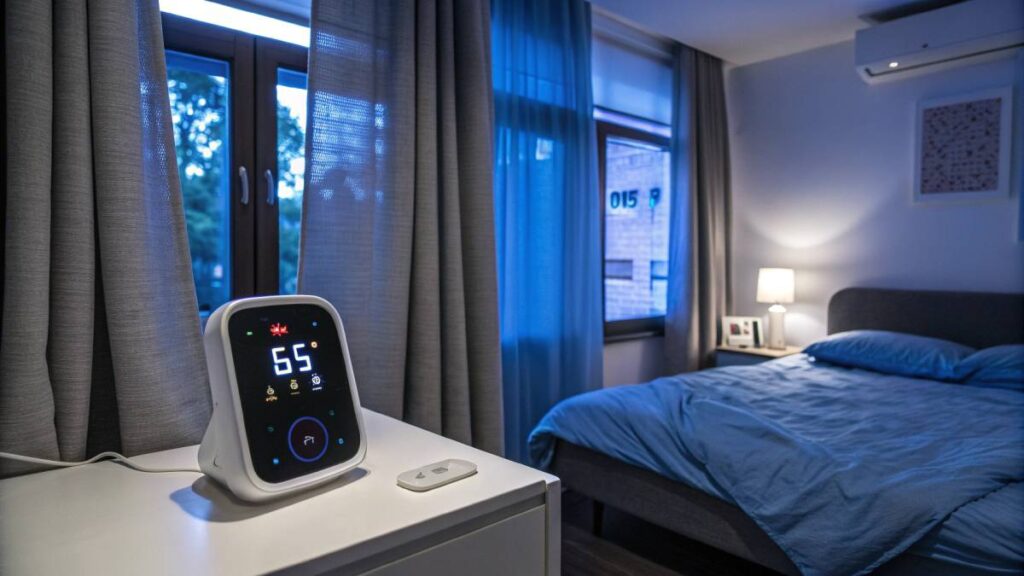
Ideal Room Temperature and Lighting
Getting the temp and lighting just right in your boudoir is like setting the mood for a date with Mr. Sandman. Fine-tuning these can send signals to your brain that it’s “do not disturb” time.
Optimal Room Temperature
Turns out, being chill is the secret sauce for a knockout sleep. Experts say 60-67 degrees Fahrenheit (15-19 degrees Celsius) is the sweet spot for catching Zzzs like a pro.
| Season | Glass Half-Full Temp (°F) | Glass Half-Full Temp (°C) |
|---|---|---|
| Winter | 60-67 | 15-19 |
| Summer | 60-67 | 15-19 |
Stick to these to keep your body’s internal clock ringing bedtime bells. Need more secrets? Pop over to our sleep improvement hacks.
Proper Lighting
The right lighting helps your brain churn out melatonin, their very own sleep potion. Here’s how to light your way to dreamland:
- Dim the Lights: Shed some light on chill mode by turning down those lamps in the evening.
- Block Out Noise and Light: Investing in some blackout curtains is like wearing sunglasses at night—they’re your superheroes against unwanted brightness.
- Avoid Blue Light: Give your screens a rest an hour before bed, or switch to those funky blue light filters. We’ve got more tricks in our sleep hygiene tips.
Get these snooze-worthy moves down, and you’re on your way to sleep euphoria. Want to play sleep scientist and discover more? Peep our article on strategies for enhancing sleep.
Technology and Sleep
Cutting Back on Screen Time Before Hitting the Hay
Scrolling through your phone or tablet before bed can mess with your shut-eye. The bright blue glow from these screens can disrupt melatonin production, the hormone that tells your body when it’s snooze time. Wanna catch some quality z’s? Cutting down on screen time before you hit the sack is definitely a step in the right direction.
| Hours Before Bed | Melatonin Takes a Hit |
|---|---|
| 1 Hour | 23% less |
| 2 Hours | 38% less |
| 3 Hours | 50% less |
Setting up a “digital curfew” can help keep those good sleeping habits in check. Experts say it’s smart to shut off all screens at least an hour before bedtime. Instead, spend that time chillin’ with a book or getting in some relaxing vibes with meditation.
For more sweet tips on how to catch those z’s, check out our article on how to improve sleep hygiene.
Sleep Apps and Whatnot: A Friend or Foe?
Sure, too much screen time can be a drag, but not all tech is a sleep villain. Some apps and gadgets may actually lend you a helping hand with your sleep game. There are tons of sleep tracking apps out there that peek into your sleep habits and offer up some nifty tips for getting better rest.
| Feature | Perk |
|---|---|
| Sleep Tracking | Keep tabs on sleep cycles and wake up like a champ |
| Relaxation Sounds | Drift off with calming sounds to lull you to sleep |
| Guided Meditations | Chill out with mindful exercises to keep jitters at bay |
When you use these tools wisely, they fit right into your sleep-improving toolkit. They come packed with data on how you sleep and might just reveal areas where you need to make some tweaks.
For more cool ideas on improving your snooze, check out articles like sleep improvement tricks and natural ways for better sleep.
Getting savvy with tech and using it smartly can really help boost your chances of a good night’s sleep. For more tips that gel with your sleep mission, dive into top sleep hacks and up your game for those blissful z’s.
Coping with Sleep Disorders
Sleep’s the ticket to feeling human, but when you’re wrestling with sleep disorders, life’s less beauty sleep, more nocturnal nightmare. There’s more to managing these troubles than just seeing a doc.
Getting Some Professional Backup
If your body’s crying for sleep and won’t shut up about it, a little professional help might just be the fairy tale end you’re dreaming of. Yeah, they’re the ones to pin a name on your sleep gremlin and prescribe the right magical fix.
Here’s what might be on the menu:
- Cognitive Behavioral Therapy for Insomnia (CBT-I): A playbook that swaps out those pesky bedtime thoughts with shiny new habits that help you snooze like a baby.
- Medications: Sometimes a little pharmaceutical help goes a long way, whether it’s a short stint or the long haul.
- Sleep Studies: A sleep study—fancy term for letting someone watch you sleep—can crack the case on why you’re whispering sweet nothings to the ceiling at 3 AM.
Getting the right sleep fix is like finding the perfect tailored suit. The sleep docs know their stuff and can hand-pick the solution that makes your nights as comfy as a warm blanket. Snag some more shut-eye know-how in our sleep habits guide.
Get to Know Your Sleep Thief
Figuring out which sleep disorder is crashing your z’s party is key to kicking it out for good. Here’s the lowdown on the main culprits:
Insomnia
Can’t get to sleep? Or back to sleep? Welcome to the insomnia club, where daytime yawning, crankiness, and wandering attention spans are the biggest members.
| Symptom | Description |
|---|---|
| Hard Time Snoozing | Taking forever (more than 30 minutes) to drift off |
| Frequent Wake-Up Calls | Waking up like a popcorn kernel in a hot pan |
| Dawn Patrol | Awakening with the birds and not falling back asleep |
Dive into our snooze solutions to tackle insomnia head-on.
Sleep Apnea
Sleep apnea’s where you stop breathing—literally—at night and your body’s like, “Whoa, who unplugged the air pipe?”
| Symptom | Description |
|---|---|
| Nightly Noise Fest | Snoring loud enough to wake the dead… or just your partners |
| Air Gasping | Waking up gasping like a fish outta water |
| Daytime Drowsies | Eerily exhausted, like you’ve been hit by the nap train |
Get the lowdown on natural ways to breathe easy at night in our deep sleep help tips.
Jumping Legs (Restless Legs Syndrome)
Imagine an itch you can’t scratch in your legs, and you’ve got restless legs syndrome. It’s the worst when you’re trying to relax.
| Symptom | Description |
|---|---|
| Jittery Legs | The itch to move your legs when all you wanna do is chill |
| Nighttime Blitz | Symptoms ramp up when the moon’s out |
| Wiggle Relief | Moving gives that ahhh feel—for a bit |
Sneak a peek at our tools for better sleep tips.
Narcolepsy
Narcolepsy’s not just about napping at random. It’s about feeling wiped out when everyone else is wide awake. Plus, there’s the muscle freeze feature—scary stuff.
| Symptom | Description |
|---|---|
| Daytime Zig-Zag | Let’s nap! Even when it feels wrong. |
| Cataplexy | Fainting spells triggered by laughs or rage… seriously. |
| Frozen in Place | When you’re neither asleep nor awake—all locked up |
Fancy more secrets for sleep success? Head over to sweet dreams advice.
Understanding your sleep nemesis and tackling it with a solid plan, crafted by pros, is top on the menu for sweet, uninterrupted sleep. Peek into our treasure trove of advice to ramp up your night’s rest with simple moves at sleep quality hacks and great zzzz strategies.
Additional Tips for Specific Groups
Everybody snoozes differently, so here’s some straightforward sleep help for different folks facing unique night-time grumbles:
Insomnia Sufferers
For those who stare at the ceiling counting sheep:
- Stick to a Routine: Try hitting the hay and getting up at the same time every day.
- Watch the Caffeine and Naps: Ditch the coffee after lunch and keep naps short enough not to mess with your pillow schedule.
- Chill Out Before Bed: Try some muscle relaxation exercises to help you unwind before diving under the covers.
Peek at our proven sleep improvement techniques for more ideas.
Shift Workers
When your 9-to-5 isn’t from 9 to 5:
- Keep It Dark: Blackout curtains are your best pals for daytime naps.
- Consistency is Key: Try to sleep and wake at the same times, even on your days off.
- Smart Caffeine Use: Sip coffee strategically to stay awake but stop guzzling before bed.
Need more suggestions? Here’s some sleep optimization advice.
Parents of Young Children
Because little ones don’t always care about your beauty sleep:
- Sleep When the Baby Sleeps: Use those golden moments when the little one naps to catch up.
- Tag Team Night Shifts: Share nighttime duties with someone if you can.
- Calm Pre-Sleep Routines: Create a soothing wind-down schedule for both you and the kiddo.
Find more sleep improvement solutions for new parents.
Stressed Professionals
When your to-do list keeps you tossing and turning:
- Chill Out Activities: Blow off steam with a hobby or some exercise.
- Work-Life Boundaries: Keep work from creeping into your downtime.
- Mindfulness Moments: Try meditation or deep breathing before bed to ease your mind.
For more help, check out science-backed sleep improvement tips.
Older Adults
Because getting older shouldn’t mean sleepless nights:
- Cozy Warming Zone: Make sure your bed setup is comfy with the right mattress and pillow.
- Regular Moves: Stay active every day but avoid bustin’ a move too close to bedtime.
- Short Daytime Naps: If you nap, keep it short and early in the day to sleep well at night.
Find more on this in our natural sleep enhancement tips.
Students
Burning the midnight oil for that last-minute cram session:
- Plan, Don’t Cram: Set up a study schedule to avoid late-night chaos.
- Avoid Buzz-Slurps: Cut back on caffeine and energy drinks before heading to bed.
- Unwind: Line up chill activities before you hit the sack, like reading or quiet tunes.
Dive into our strategies for enhancing sleep for students.
These tips are all about getting you the right kind of shut-eye. For more all-encompassing advice, check out our top sleep improvement tips.
Main Tips
- Consistency is King: Maintain the same sleep and wake times—even on weekends—to regulate your body’s internal clock.
- Create a Wind-Down Ritual: Develop a 30-minute pre-sleep routine that signals to your body it’s time to relax (reading, gentle stretching, warm bath).
- Optimize Your Sleep Environment: Invest in a quality mattress and pillows, maintain a cool room temperature (60-67°F), and eliminate light and noise disruptions.
- Mind Your Daytime Habits: Exercise regularly (but not within 3 hours of bedtime), manage caffeine intake (none after 2 PM), and get natural sunlight exposure daily.
- Manage Evening Light Exposure: Dim household lights 2 hours before bed and eliminate blue light from screens at least 1 hour before sleep.
- Address Stress Proactively: Practice relaxation techniques like deep breathing, progressive muscle relaxation, or meditation to calm an active mind.
- Watch What (and When) You Eat: Avoid heavy meals within 3 hours of bedtime and limit alcohol, which disrupts REM sleep.
- Reset When Necessary: If you can’t fall asleep within 20 minutes, leave your bedroom and do something relaxing until you feel sleepy.
Conclusion
The journey to better sleep isn’t about finding a one-size-fits-all solution—it’s about discovering what works specifically for your body and lifestyle. By implementing the strategies outlined in this guide, from establishing consistent bedtimes to creating a sleep sanctuary in your bedroom, you’re taking powerful steps toward reclaiming the restorative rest your mind and body crave.
Remember that quality sleep isn’t a luxury—it’s a fundamental pillar of health that affects everything from your cognitive function and emotional resilience to your physical wellbeing and immune response. Small, consistent changes often yield the most significant results. Start with one or two strategies that resonate most with you, whether that’s cutting back on afternoon caffeine, creating a pre-sleep relaxation ritual, or investing in blackout curtains.
For those struggling with persistent sleep issues, don’t hesitate to seek professional guidance. Sleep disorders are highly treatable, and addressing them promptly can transform not just your nights but your entire life quality. Your journey to better sleep begins with tonight’s choices—make them count.
FAQs
What is the ideal room temperature for optimal sleep?
The ideal sleeping temperature falls between 60-67°F (15-19°C). This cooler environment helps facilitate the natural drop in core body temperature that signals your body it’s time to sleep. Maintaining this temperature range consistently throughout the night helps prevent disruptions from being too hot or cold.
How does screen time before bed affect sleep quality?
Screen time before bed significantly disrupts sleep by suppressing melatonin production. The blue light emitted from phones, tablets, and computers can reduce melatonin by up to 50% when used within three hours of bedtime. This makes it harder to fall asleep and reduces overall sleep quality. Implementing a digital curfew at least one hour before bed can dramatically improve sleep onset and quality.
What foods should I avoid before bedtime?
Heavy meals, spicy foods, and foods high in fat or protein should be avoided within 3 hours of bedtime as they can cause indigestion and disrupt sleep. Caffeine (coffee, tea, chocolate) should be avoided after 2 PM, and alcohol, while initially sedating, disrupts REM sleep and causes fragmented sleep patterns. Opt instead for sleep-promoting foods like tart cherries, kiwi, or warm milk.
How can I establish a sleep routine if I work rotating shifts?
Establishing a sleep routine with rotating shifts requires strategic planning. Use blackout curtains and white noise machines to create a sleep-conducive environment regardless of the time. Maintain consistent sleep and wake times within each shift period. Use strategic light exposure to reset your circadian rhythm—bright light when you need to be alert and darkness when preparing for sleep. Consider discussing a more consistent shift rotation with your employer if possible.
How much sleep do I actually need?
Sleep needs vary by age and individual factors, but most adults require 7-9 hours of quality sleep per night. Teenagers need 8-10 hours, school-age children 9-12 hours, and infants substantially more. The best measure isn’t just hours but how you feel—if you’re consistently tired despite getting “enough” sleep, you may need more rest or should evaluate your sleep quality.
When should I seek professional help for sleep problems?
Seek professional help if you experience persistent sleep issues (lasting more than a month) despite implementing good sleep hygiene practices. Warning signs include: taking more than 30 minutes to fall asleep regularly, waking frequently during the night, excessive daytime sleepiness, loud snoring with gasping or choking sounds, or if sleep problems significantly impact your daily functioning, mood, or overall health.
Resources
- National Sleep Foundation – Comprehensive resource for sleep research, tips, and tools
- American Academy of Sleep Medicine – Professional information on sleep disorders and treatments
- Harvard Sleep Medicine – Evidence-based sleep resources from Harvard Medical School
- Sleep.gov – CDC’s portal for sleep health information
Final Thoughts
Sleep isn’t just a biological necessity—it’s a foundation upon which our entire well-being is built. The modern world has made quality sleep more challenging to achieve, but also more important than ever. By approaching sleep as a skill that can be developed rather than something that simply happens (or doesn’t), you empower yourself to make meaningful changes.
Remember that consistency is key. Your body thrives on routine, and the benefits of improved sleep habits compound over time. Don’t be discouraged if you don’t see immediate results—some adaptations take weeks to fully integrate into your body’s rhythms.
Perhaps most importantly, cultivate a positive relationship with sleep itself. Instead of viewing bedtime as another obligation or seeing sleep as time “wasted,” recognize it as the essential restorative process that allows you to show up fully in your waking life. When you prioritize sleep, you’re not just investing in better nights—you’re investing in better days, better health, and ultimately, a better life.
Quality Sleep Essentials
Mattresses & Bedding
- Nectar Memory Foam Mattress – Experience cloud-like comfort with this medium-firm memory foam mattress that supports proper spinal alignment. Your best sleep starts with the right foundation! Shop Now
- Brooklinen Luxe Core Sheet Set – Transform your sleep with these buttery-soft 480 thread count sheets that stay cool all night long. Feel the difference tonight
Sleep Environment Enhancers
- NICETOWN Blackout Curtains – Create your perfect sleep sanctuary with these 100% blackout curtains that block light and reduce noise. Wake refreshed every morning! Create your sleep sanctuary
- Hatch Restore Sound Machine & Sunrise Alarm – Fall asleep naturally and wake gently with customizable sound and light programs that work with your body’s rhythms. Upgrade your sleep routine
Sleep Tracking & Improvement
- Oura Ring Gen3 – Discover your personal sleep patterns with the most accurate sleep tracker on the market. Know exactly what’s working and what’s not. Understand your sleep better
- Philips SmartSleep Wake-Up Light – Sync with your natural circadian rhythm using this clinically proven sunrise simulation alarm. No more jarring wake-ups! Wake naturally
Stress & Anxiety Relief
- YnM Weighted Blanket – Experience the calming embrace of deep pressure stimulation that reduces anxiety and helps you fall asleep faster. Feel the difference tonight
- This Works Deep Sleep Pillow Spray – Transform your bedroom with this award-winning natural sleep aid featuring lavender, chamomile, and vetivert. 89% of users report better sleep! Drift off easily

